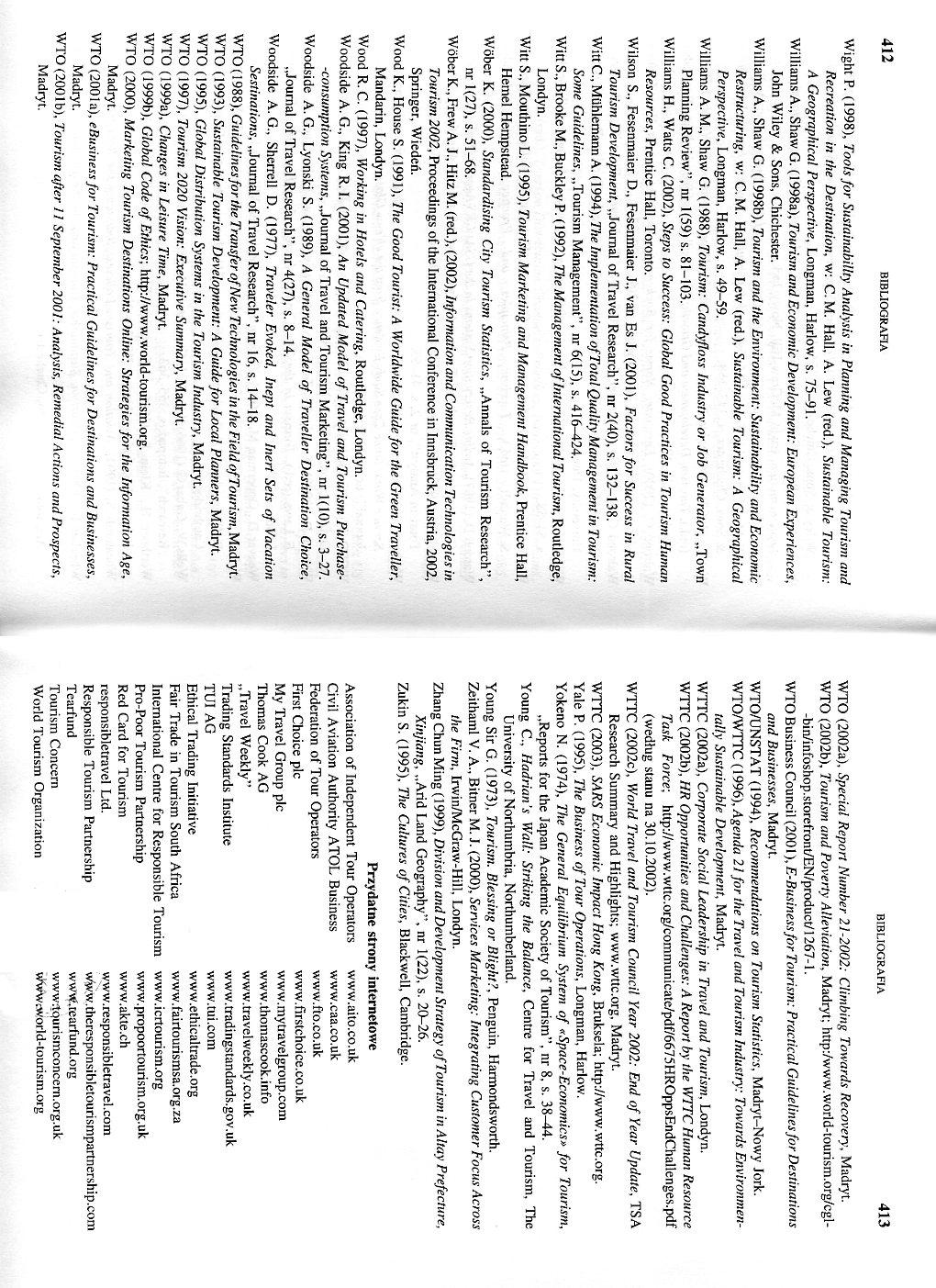ZT207 (2)

412 BIBLIOGRAFIA
Wight P. (1998), Toolsfor Sustainabillty Analysis in Planning and Managing Tourism and Recreation in the Destination, w: C. M. Hall, A. Lew (red.), Sustainahle Tourism: A Geographical Perspective, Longman, Harlow, s. 75-91.
Williams A., Shaw G. (I998a), Tourism and Economic Development: European Experiences, John Wiley & Sons, Chichester.
Williams A., Shaw G. (1998b), Tourism and the Environment: Sustainabillty and Economic Restructuring, w: C. M. Hall, A. Lew (red.), Sustainahle Tourism: A Geographical Perspectivey Longman, Harlow, s. 49-59.
Williams A. M., Shaw G. (1988), Tourism: Candyfloss Industry or Job Generator. „Town Planning Review”, nr 1(59) s. 81-103.
Williams H., Watts C. (2002), Steps to Success: Global Good Practices in Tourism Humań Resources, Prentice Hall, Toronto.
Wilson S., Fesenmaier D., Fesenmaier J., van Es J. (2001), Factors for Success in Rural Tourism Development, „Journal of Travel Research”, nr 2(40), s. 132-138.
Witt C., Miihlemann A. (1994), The lmplementation ofTotal Quality Management in Tourism: Some Guidelines, „Tourism Management”, nr 6(15), s. 416—424.
Witt S., Brooke M., Buckley P. (1992), The Management of International Tourism, Routledge, Londyn.
Witt S., Mouthino L. (1995), Tourism Marketing and Management Handbook, Prentice Hall, Hemel Hempstcad.
Wober K. (2000), Standardising City Tourism Statistics, „Annals of Tourism Research”, nr 1(27), s. 51-68.
Wober K., Frew A. J., Hitz M. (red.), (2002), Information and Communication Technologies in Tourism 2002, Proceedings of the International Confcrcnce in Innsbruck, Austria, 2002, Springer, Wiedeń.
Wood K., House S. (1991), The Good Tourist: A Worldwide Guide for the Green Travellery Mandarin, Londyn.
Wood R. C. (1997), Working in Hotels and Catering, Routledge, Londyn.
Woodsidc A.G., King R. 1. (2001), An Updated Model of Travel and Tourism Purchase--consumption Systems, „Journal of Travcl and Tourism Marketing”, nr 1(10), s. 3-27.
Woodside A. G., Lyonski S. (1989), A General Model of Traveller Destination Choice, „Journal of Travel Research”, nr 4(27), s. 8-14.
Woodsidc A. G., Sherrell D. (1977), Traveler Evoked, Inept and Inert Sets of Vacation Sestinations, „Journal of Travel Research”, nr 16, s. 14-18.
WTO (1988), Guidelines for the Transfer of New Technologies in the Field of Tourism, Madryt.
WTO (1993), Sustainahle Tourism Development: A Guide for Local Planners, Madryt.
WTO (1995), Global Distribution Systems in the Tourism Industry, Madryt.
WTO (1997), Tourism 2020 Vision: Executive Summary, Madryt.
WTO (1999a), Changes in Leisure Time, Madryt.
WTO (1999b), Global Codę of Ethics’, http://www.world-tourism.org.
WTO (2000), Marketing Tourism Destinations Online: Strategies for the Information Age, Madryt.
WTO (200 la), e Business for Tourism: Practical Guidelines for Destinations and Businesses, Madryt.
WTO (2001 b), Tourism after 11 September 2001: Analysis. Remedial Actions and Prospects, Madryt.
WTO (2002a), Special Report Number 21-2002: Climbing Towards Recovery, Madryt.
WTO (2002b), Tourism and Poverty Alleviation, Madryt; http:Avww.world-tourism.org/cgl--bin/infoshop.storefront/EN/product/1267-1.
WTO Business Council (2001), E-Business for Tourism: Practical Guidelines for Destinations and Businesses, Madryt.
WTO/UNSTAT (1994), Recommendations on Tourism Statistics, Mądryt-Nowy Jork.
WTO/WTTC (1996), Agenda 21 for the Trarel and Tourism Industry: Towards Environmen-tally Sustainahle Development, Madryt.
WTTC (20O2a), Corporate Social Leaderslup in Travel and Tourism. Londyn.
WTTC (2002b), HR Opportunities and Challenges: A Report by the WTTC Humań Resource Task Force\ http://www.wttc.org/communicate/pdf/6675HROppsEndChallenges.pdf (według sianu na 30.10.2002).
WTTC (2002c), World Travel and Tourism Council Year 2002: End of Year Update, TSA Research Summary and Highlights; www.wttc.org. Madryt.
WTTC (2003), SARS Economic Itnpact Hong Kong, Bruksela; http://www.wttc.org.
Yale P. (1995), The Business ofTour Operations, Longman, Harlow.
Yokeno N. (1974), The General Ecjuilibrium System of «Space-Economics» for Tourism. „Reports for the Japan Academic Society of Tourism”, nr 8. s. 38-44.
Young C., Hadrian 's Wall: Stri king the Balance, Centre for Travel and Tourism, The University of Northumbria, Northumberland.
Young Sir G. (1973), Tourism. Blessing or Blight?. Penguin, Harmondsworth.
Zeithaml V. A., Bitner M. J. (2000), Services Marketing: Integrating Customer Focus Across the Firm, Irwin/McGraw-Hill, Londyn.
Zhang Chun Ming (1999), Division and Deyelopment Strategy of Tourism in Altay Prefecture, Xinjiang, „Arid Land Geography”, nr 1(22), s. 20-26.
Zukin S. (1995), The Cultures ofCities, Blackwell, Cambridge.
Przydatne strony internetowe
TUI AG
Association of Independent Tour Operators
Civil Aviation Authority ATOL Business
Fcderation of Tour Operators
First Choice pic
My Travel Group pic
Thomas Cook AG
„Travel Weekly”
Trading Standards Institute
Ethical Trading Initiative
Fair Trade in Tourism South Africa
International Centre for Responsibłe Tourism
Pro-Poor Tourism Partnership
Red Card for Tourism
responsiblctravcl Ltd.
Responsibłe Tourism Partnership
Tearfund
Tourism Concern
World Tourism Organization www.aito.co.uk
www.responsibletravel.com www.thcresponsibletourismpartnership.com w w\V. tearfu nd .org www.tpu ri smconce rn. org. u k WWW rvvorld-touri.sm.org
Wyszukiwarka
Podobne podstrony:
Sławomir Cieślik Electric energy quality analysis in distribution and
P1190240 390 BIBLIOGRAFIA BIBLIOGRAFIA391 Mtirak t, 1998, , 7MMN* * PMńocia nie uwiązani zagadka, lw
38370 skanuj0019 (6) 196 3. Wybrane problemy planowania zagospodarowania turystycznego nu. Według P.
251 (28) Bibliografia Alheit P. (1994), Taking the Knocks: Youłh Unemployment and Biography - A Qual
00121 ge08f5e71e20195f362e2605eea9911 122 Simpson & Keats by a trade-off analysis in the region
00134 ?0fccfa985e4cfd668b181d101a42da 135 Optimization and Sensitivity Analysis Table 5. Example 1
00139 >858430acb91880687589de10557be5 140Simpson & KeatsEconomic-Statistical Approach Using Tra
00156 ?7280a85750cd771225fd1fc4ecd9cf 157 Optimization and Sensitivity Analysis Goel, A. L., Jain,
Szaraniec Barbara, dr inż. Bibliografia Publikacji Pracowników AGH [4/10] [24] In
sustainability issue in relation to the soybean production in the Amazone region in Latin America. S
Program studiów 1 semestr » Real and Complex Analysis in Mathematical Modelling »
Katarzyna Maruszewska The Application of Correspondence Analysis in Research on Determinants of IWig
50107 mity121 Bibliografia Ackerheil H. V. 1983 Góttheiten und Kultstatten in wid urn Oldenburg in W
iml. 5 (1998-1999), s. 467, - 6. NoII, Diplomatic Assurances and the Silence of Hu
więcej podobnych podstron